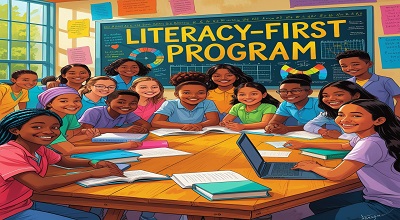The literacy-first program improved test scores
Literacy-first program improved test scores: In an era where standardized test scores often measure educational outcomes, one school defied the odds by embracing a literacy-first program. This transformative approach not only improved reading and writing skills but also revitalized the entire school culture.
At TeacherEducator.com, we explore how this program turned a struggling school into a thriving academic community. From teacher training to student engagement, this deep dive uncovers the strategies, challenges, and triumphs of a literacy-focused revival.
The Crisis: A School in Decline
Falling Test Scores and Low Morale
The school in question faced plummeting reading proficiency rates, with over 60% of students below grade level. Discipline issues were rising, and teacher turnover was high.
Identifying the Root Cause: Literacy Gaps
Administrators discovered that students struggling in math and science also had weak reading comprehension. Without strong literacy skills, learning in other subjects became nearly impossible.
The Literacy-First Approach: What It Is and Why It Works
Defining a Literacy-First Program
A literacy-first model prioritizes reading, writing, and critical thinking across all subjects—not just English class.
Research Behind Literacy as a Foundation
Studies show that students with strong literacy skills perform better in all academic areas. The National Reading Panel emphasizes phonics, fluency, vocabulary, and comprehension as key pillars.
Implementation: Steps to Transform a School
Teacher Training and Professional Development
Educators received intensive workshops on evidence-based literacy strategies, including:
- Structured reading interventions
- Writing across the curriculum
Integrating Literacy Across All Subjects
Math teachers incorporated word problems with real-world applications, while science classes emphasized research and report writing.
Engaging Parents and the Community
Workshops for families helped reinforce reading habits at home, and local libraries partnered with the school for book drives and reading challenges.
Measurable Success: Data and Outcomes
Improved Standardized Test Scores
Within two years, reading proficiency jumped from 40% to 75%. Math and science scores also saw significant gains.
Higher Graduation and College Enrollment Rates
The school’s graduation rate increased by 20%, with more students pursuing higher education.
Student and Teacher Confidence Boost
Surveys showed that 85% of teachers felt more effective, and students reported greater enjoyment in learning.
Challenges and How They Were Overcome
Resistance to Change
Some educators were hesitant to shift from traditional methods. Ongoing coaching and success stories helped win them over.
Budget Constraints and Resource Allocation
Grants and community fundraising provided additional books, technology, and training materials.
Case Study: A Real School’s Journey
Before and After the Literacy-First Program
- Before: Low engagement, high dropout rates.
- After: A vibrant learning environment with motivated students.
Testimonials
- “This program changed everything. Our students are now confident readers.” – Principal
- “I used to hate reading. Now I love it!” – 8th-grade student
How Other Schools Can Adopt This Model?
Key Steps for Replication
- Assess current literacy levels.
- Train teachers in structured literacy methods.
- Embed reading and writing in every subject.
Tools and Resources
- Free literacy assessment tools
- Recommended reading lists
The Future of Literacy-First Education
Scaling the Program District-Wide
Other schools in the district are now adopting the model.
Policy Changes to Support Literacy
Advocates are pushing for state and federal funding to expand literacy initiatives.
Conclusion: Why Literacy Should Be Every School’s Priority
A literacy-first approach isn’t just about reading—it’s about empowering students for lifelong success.
FAQs About Literacy-First Programs
1. What is a literacy-first program?
A school-wide approach that prioritizes reading and writing in all subjects to improve overall academic success.
2. How long does it take to see results?
Most schools see improvements within 1-2 years, with significant gains by year three.
3. Do teachers need special training?
Yes, professional development in structured literacy methods is essential.
4. Can this work in low-budget schools?
Yes, with creative funding (grants, community partnerships), even under-resourced schools can succeed.
5. Where can schools get started?
Visit TeacherEducator.com for free resources and guides.
